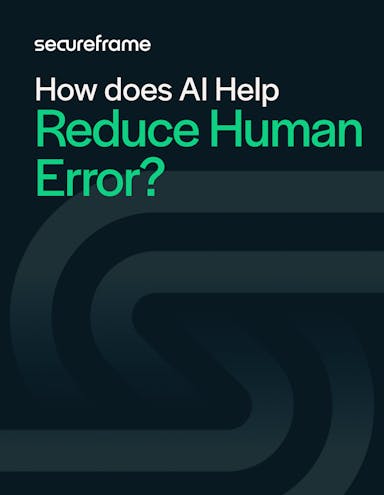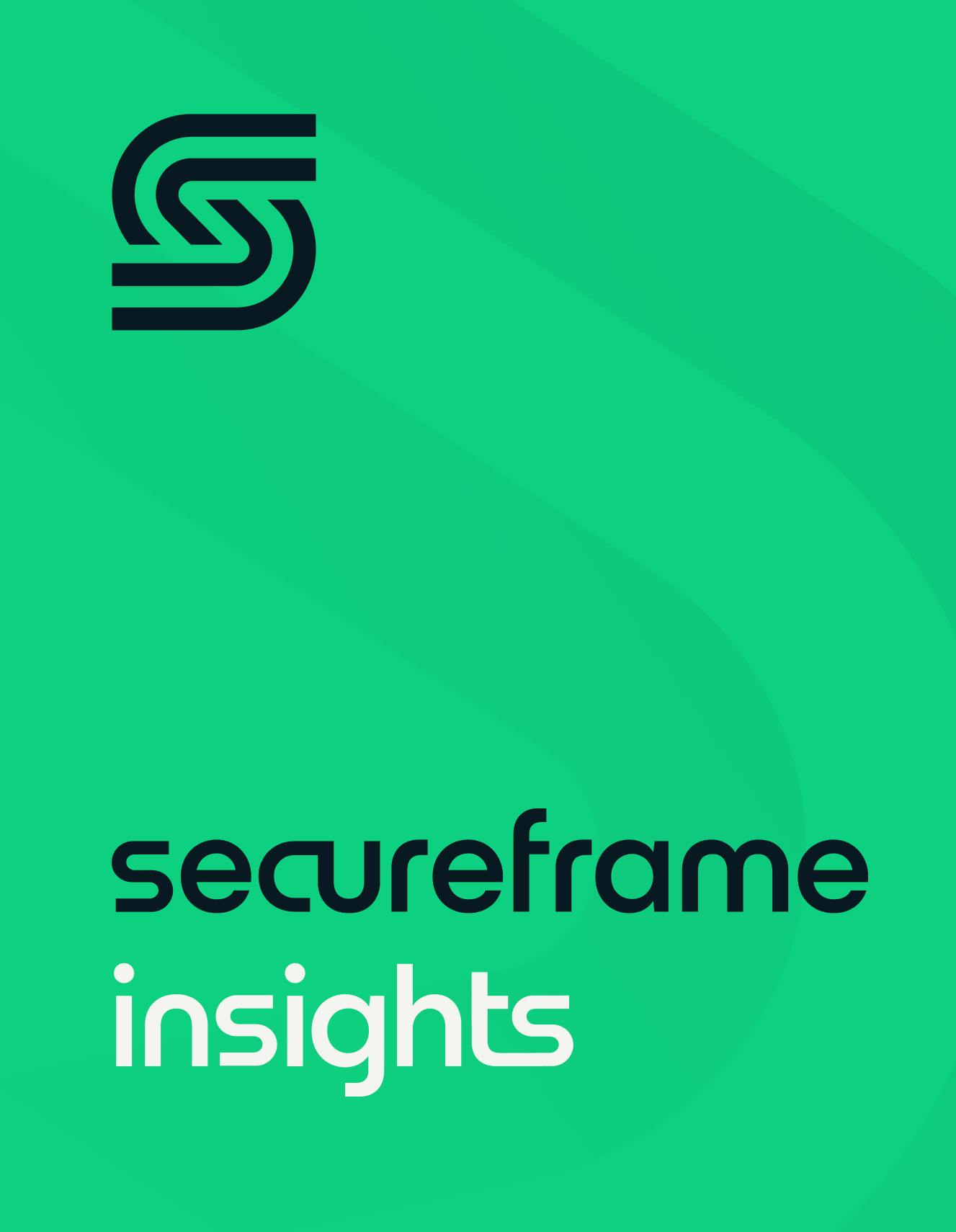
11 Tips to Effectively Reduce Human Errors in the Workplace
Anna Fitzgerald
Senior Content Marketing Manager
Rob Gutierrez
Senior Cybersecurity and Compliance Manager, CISA, CCSK, CMMC RP
Despite our best efforts, humans make mistakes. It’s in our nature. But human error in the workplace can have serious consequences on cybersecurity and business continuity.
In 2023, 43% of people admitted to making mistakes at work that compromised cybersecurity.
To help protect your organization, we’ll dig into the external factors that lead to human error and offer solutions to help you develop a human error prevention strategy.
What is human error?
Human error is an unintentional action that goes against a business’s established practices, guidelines, or code of conduct. It can cause significant damage to a company’s reputation, bottom line, and future.
While human error is not 100% preventable, understanding why human error happens and taking steps to prevent it can help you avoid costly mistakes and improve processes.
The danger of human error for cybersecurity
Employees are often the most vulnerable target for cybercriminals, making human error prevention a key component of your risk management plan.
In 2023, 73% of data breaches involved the human element, either via error, privilege misuse, use of stolen credentials, or social engineering. This percentage is even more alarming considering that data breaches caused by human error cost businesses an average of $3.33 million.

How Does AI Reduce Human Error in Cybersecurity?
This ebook provides a high-level overview of the crucial role AI is playing in mitigating risks of data breaches, regulatory violations, financial losses, and more, using examples of real-world applications in cybersecurity and IT compliance.
Human error types
There are two categories of human error: thinking errors and action errors. It’s important to note that both of these error types are unintentional.
Action errors occur when a person carries out an action incorrectly, such as when the task is highly repetitive. Thinking errors occur when a person correctly carries out the wrong task because of a knowledge gap or unclear instructions.

Knowledge-based mistakes
Error type: Thinking error
Knowledge-based mistakes occur when a person doesn’t fully understand a task and uses limited knowledge to carry out a task incorrectly.
An example of a knowledge-based mistake would be filling a rental car with regular gas rather than premium because the rental company didn’t tell you it requires premium gas.
Rule-based mistakes
Error type: Thinking error
This kind of mistake hinges on how a rule is applied. A mistake can be made if a good rule (one that has been successfully used in the past) is applied to the wrong situation, or if the wrong rule has been applied.
An example of a rule-based mistake would be driving in the left lane on the highway without the intention to pass someone.
Slips of action
Error type: Action error
Slips of action happen when your action is different from what you intended. These often happen because a person isn’t paying sufficient attention to the task at hand.
A slip of action could be something as simple as taking the wrong exit on your daily commute home because you were distracted and not fully concentrated on the road.
Memory lapses
Error type: Action error
A memory lapse occurs when you forget to do something. This is also known as a lapse in short-term memory.
An example of a memory lapse would be forgetting to put on your seatbelt when you get into a car.
Both slips and lapses are considered skill-based errors. This type of error occurs when you are doing routine and familiar tasks. When carrying these tasks out, you rely on well-developed skill patterns in your brain and are more likely to make a mistake without realizing it.
Recommended reading

190 Cybersecurity Statistics to Inspire Action This Year
Factors that lead to human error
While human error isn’t completely preventable, understanding common causes can help you develop more mindful strategies for addressing error head-on.

Stress
It’s no surprise that stress is a leading cause of mistakes. Stress inhibits our ability to
think clearly and also produces physical symptoms such as high blood
pressure, headaches, and muscle tension.
According to Tessian research, 52% of survey respondents said they make more mistakes at work when they are stressed. The American Psychological Association identifies some of the most common factors that lead to workplace stress as long hours (54%) and too heavy of a workload (50%).
You can help employees manage stress in a number of ways. Here are a few ideas:
- Train your management team to spot common signs of stress
- Encourage employees to ask for help when they feel overwhelmed, and be ready to offer support
- Create designated quiet time (such as Meeting-Free Mondays) for employees to focus on high-priority tasks
- Encourage employees to identify their most productive hours (if unsure, try the chronotype quiz) and use that information to create a schedule that works best for them
Fatigue
Sleep deprivation is another leading cause of human error. This could be caused by overworking or revenge bedtime procrastination, which is the decision to sacrifice sleep for the activities you weren’t able to do during the day.
Fatigue can result in slower reactions, reduced ability to process information, memory lapses, decreased awareness, and reduced coordination.
How to help: Encourage employees to use their paid time off and take breaks throughout the day.
Multi-tasking
Mistakes often happen when a person is trying to do too many tasks at once. When you switch from task to task without finishing the first, you can lose up to 40% of your productivity.
Toggling back and forth between tasks can take a toll on both emotional wellbeing and mental health.
How to help: Encourage employees to determine their most productive hours of the day and focus on high-priority or harder tasks during that time frame.
Poor training
Not providing employees with proper training is also a cause for human error.
Often, employees who were not trained properly will attempt to finish tasks or follow procedures to the best of their knowledge, but this can leave out important steps and cause long-term problems if not caught early on.
How to help: Commit to ongoing employee training — not just for new hires — on areas that are historically prone to human error within your organization.
Burnout
Employees suffering from burnout tend to have less mental and physical energy available, making them more prone to cognitive errors, accidents, and injuries.
Burnout can have serious medical consequences such as heart disease and high blood pressure, not to mention the toll it takes on the quality of work and the ability to efficiently complete tasks.
How to help: Ensure your teams are properly staffed and workloads are well balanced.
Negligence
Negligence, or a disregard for an established process or rule, is another cause for error. However, this error type is deliberate and intentional, unlike thinking and action errors described above.
How to help: Ensure employees understand why rules and processes are in place and impose consequences for errors caused by negligence.
Faulty memory
Faulty memory can affect decision making and lead to human error. For example, an employee relying on memory to complete a set of actions may miss a step or complete them in the incorrect order. This is particularly dangerous in the health care industry because errors can result in near-misses (close calls that could easily have resulted in patient harm) or actual patient harm.
How to help: Provide cognitive aids, like checklists, automated alerts, and/or compliance readiness tools with tasks & notification features like Secureframe, to reduce employees’ reliance on memory and ensure they aren’t missing any essential tasks during planning or execution.
Miscommunication
Inadequate or unstructured communication between team members can also result in human error. If an individual doesn’t have all the necessary information at the right time, then they are more likely to make a mistake.
To minimize communication-related errors, implement processes to foster communication among team members.
How to help: Provide aids or processes for structured communication, like talkbacks, alert phrases, checklists, and standardizes hand offs.
Get industry insights, news & more in your inbox
Secureframe Insights is our monthly newsletter covering the latest cybersecurity and compliance news, insights, and events — from changing regulations to compliance checklists and more.
Join thousands of subscribers in getting these expert insights delivered straight to your inbox.

How to prevent human error in the workplace: 11 tips
Errors are an opportunity for us to learn and hopefully avoid mistakes from happening again. We talked with experts to gain their insight into the human error prevention steps that have worked for them.
1. Identify error-prone parts of your business
Before you begin a human error prevention strategy, it’s important to identify the areas of your business that are prone to errors. You can do this through a root cause analysis that provides insight into the underlying causes and helps to fix the issue.
“Processes can be set up to prevent or limit future occurrences of identified problems,” says Noriana Radwan, Expert Associate in Human Factors at LISKE Accident & Injury Experts. “For example, in recurring manual tasks such as data entry, automated systems can help to prevent and limit mistakes. For recurring multi-step tasks, checklists can be helpful as they provide step-by-step instructions on how to complete a multi-step task by focusing on one step at a time.”
2. Employ automation where you can
Many human errors can be avoided by automating repetitive tasks. Automation reduces the number of manual tasks your employees have to complete, which reduces the risk of human errors.
“When you automate repetitive tasks like payroll or auto-populating forms, you only have to check the information once when you enter it for the first time,” says Logan Mallory, Vice President of Motivosity. “This greatly reduces human errors like typos, transposing numbers, or entering data into the wrong field. Automation also saves time and frees people up to focus on other tasks.”
3. Commit to continuous employee training
To keep up with changing processes and technologies, employees should be given consistent and flexible training.
These training sessions should serve as a reminder about important processes, provide details on any new processes, and introduce the team to the company’s biggest risks and how the entire company can work to mitigate them.
Additionally, public awareness campaigns can also keep important information top of mind.
“Even after training sessions, cybersecurity information can easily be forgotten if employees are not reminded of the hazards they face on a daily basis,” says Jamie Opalchuk, founder and CEO of HostPapa. “Raising awareness is most easily accomplished through poster campaigns and email reminders that may include general information, tips and techniques, or more specific guidance about your business's operations.”
4. Increase employee oversight and accountability
Ensuring that employees understand their responsibilities and are held accountable for their actions can lead to fewer mistakes.
To do so, establish performance metrics and goals for individuals in their roles. When possible, assign tasks to individuals and automatically send notifications to remind them to complete them on a recurring basis. For example, if you’re using Secureframe, you can assign policy reviews and training to employees directly in the platform and send them notifications to complete those annually.
Taking these steps will give employees a sense of ownership for tasks and outcomes, which can improve accountability and reduce errors.
5. Create detailed process documents
Checklists and process docs should be available to all employees and serve as a way to double-check they’re following proper procedure.
It’s helpful to create these for more complex processes within your company. However, if your business has the resources, it can be helpful to document all workplace procedures and store them in an easily accessible place such as the cloud.
6. Invest in an offsite cloud data backup
Human error leads to 50% of data loss incidents, according to research from Netwrix.
Data loss can have a catastrophic impact on business operations, so it’s important to invest in regular data backups. A secure, automated, offsite backup can help with disaster recovery and business continuity should a data loss incident occur.
Recommended reading

110 Compliance Statistics to Know for 2025
7. Improve internal communication lines
Communication is key in preventing human error incidents.
Because many types of human error are caused by a misunderstanding of rules or processes, encouraging open lines of communication between employees and their managers can help avoid certain mistakes and improve understanding of the task at hand.
When trust is established between an employee and their manager, they will feel more comfortable asking clarifying questions. This can be particularly helpful when an employee is doing a new task for the first time or a process has been updated.
8. Use the Principle of Least Privilege
The Principle of Least Privilege is a cybersecurity concept that limits user access only to individuals that need that information to complete their job. This is a helpful way to prevent data breaches because it limits the number of people who have access to sensitive information.
“It’s important to allow access to sensitive data only when absolutely necessary, “ says Chris Sesi, Head of Compliance at Secureframe. “Granting user access to a select few key individuals can prevent data breaches and accidental data deletion.”
9. Change the narrative around mistakes
The most effective way to rectify mistakes is to learn from them as soon as possible. When employees are afraid to speak up about errors they’ve made, it can lead to continually covering up mistakes rather than learning from them.
Rather than discouraging or punishing employees for mistakes, encourage them to speak up and point out organizational problems that may have contributed to mistakes.
When a problem is discovered, treat it as a learning opportunity rather than a chance to punish your employees. The outcomes will be clear communication, improved trust, and a reduction in the number of mistakes made.
“It's important to remember that solving problems, particularly when it comes to human error, is a team effort, which is why collecting people's opinions is so important,” says Josh Pelletier, CMO at BarBend. The most effective method of preventing human error in a company is to involve your employees in the solution.”
10. Reduce the number of communication channels
Toggling back and forth between several communication platforms can increase the potential for distraction and the risk of key information being lost between platforms.
“One of the most effective methods to accomplish this is to use a single, dependable (and secure) communication system,” says Sumit Bansal, founder and CEO of TrumpExcel. “To avoid having to juggle a variety of channels and means of communication (such as email, SMS, webchat, etc.), choose a single platform to use for all communication. This guarantees that your employees have access to all of the information they require in a single location, allowing them to execute their jobs more efficiently.”
11. Set up processes for continuous improvement
Setting up processes for continuous improvement can help you avoid repeating the same or similar mistakes.
For example, consider establishing a feedback mechanism where employees can report errors or suggest process improvements. You can then use this feedback to continually refine procedures and reduce the likelihood of errors. Performance reviews can also help generate this type of feedback.
Also, have a process in place when errors do occur. This should involve conducting a thorough root cause analysis to understand why they happened and then using those results to implement preventative measures.
Human error prevention frameworks
The frameworks below can help provide or shape the human error prevention strategies at your organization.
Swiss Cheese Model of Accident Causation
In the Swiss Cheese Model, a barrier or line of defense represents a slice. Each slice has holes, or gaps that allows a hazard condition to progress. When these holes line up, a small issue becomes a major one.
How to use it: Establish multiple levels of barriers, then identify and fill the holes at each level by adding automation to reduce the risk of human error or creating detailed process documentation to reduce common mistakes.
STAR Method
The STAR method is a simple technique for preventing skill-based errors. STAR stands for Stop, Think, Act, and Review.
How to use it: Use the STAR method before completing a routine task, like entering data into a system or submitting an email with an attachment.
- Stop and focus fully on the task at hand.
- Think about what must be done.
- Act and perform the task.
- Review for the desired result.
Human Error Assessment Reduction Technique (HEART)
The HEART Method assumes that every time a task is performed, there is a possibility of failure affected by one or more error-producing conditions (EPCs), such as tiredness.
How to use it: Use HEART to assess how likely it is that a task or process will fail based on the potential of human error, and then develop and implement measures that will either prevent the human error occurring in the first place, limit the consequences of the error, or improve the chances of recovering from the error.
- Classify the task by type (e.g. routine or complex)
- Identify the error-producing condition (e.g. time or staffing constraint)
- Determine the EPC’s impact on the task
- Calculate the human error potential for the task
- Develop risk reduction measures
How Secureframe can help automate tasks to reduce human error
Mistakes are bound to happen in the workplace. However, shifting the way we think about mistakes from being a nuisance to a learning opportunity can help to pinpoint the root cause and create better processes for the future.
Automating repetitive tasks can be a simple yet effective way to prevent mistakes from occurring. Secureframe makes it easy to automate evidence collection and continuous monitoring to help your business stay compliant with industry standards like SOC 2 and HIPAA and reduce your team’s workload. Secureframe also allows you to create and assign tasks and send out notifications of these tasks to help reduce faulty memory and/or human errors.
For even more human error resources, we created this infographic to help illustrate the importance of human error prevention.

FAQs
What is an example of a human error?
An example of a human error is an anesthesiologist forgetting to check the anesthesia machine before a patient’s procedure.
What are the 12 common human factor errors?
There are twelve common factors or preconditions of human error that can result in accidents or incidents. These are:
- Lack of communication
- Distraction
- Lack of resources
- Stress
- Complacency
- Lack of teamwork
- Pressure
- Lack of awareness
- Lack of knowledge
- Fatigue
- Lack of assertiveness
- Norms

Anna Fitzgerald
Senior Content Marketing Manager
Anna Fitzgerald is a digital and product marketing professional with nearly a decade of experience delivering high-quality content across highly regulated and technical industries, including healthcare, web development, and cybersecurity compliance. At Secureframe, she specializes in translating complex regulatory frameworks—such as CMMC, FedRAMP, NIST, and SOC 2—into practical resources that help organizations of all sizes and maturity levels meet evolving compliance requirements and improve their overall risk management strategy.

Rob Gutierrez
Senior Cybersecurity and Compliance Manager, CISA, CCSK, CMMC RP
Rob Gutierrez is an information security leader with nearly a decade of experience in GRC, IT audit, cybersecurity, FedRAMP, cloud, and supply chain assessments. As a former auditor and security consultant, Rob performed and managed CMMC, FedRAMP, FISMA, and other security and regulatory audits. At Secureframe, he’s helped hundreds of customers achieve compliance with federal and commercial frameworks, including NIST 800-171, NIST 800-53, FedRAMP, CMMC, SOC 2, and ISO 27001.